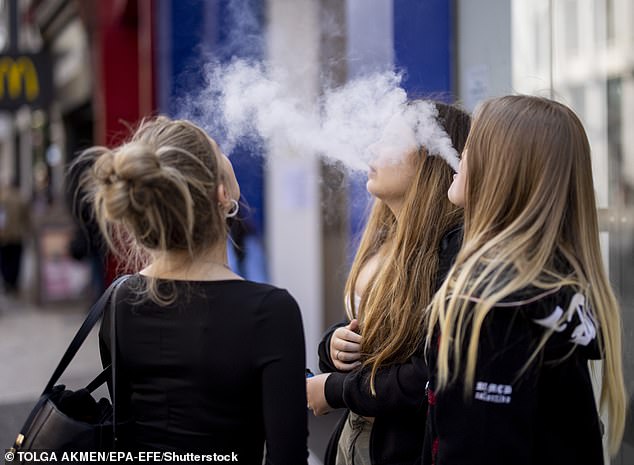The number of people using high-strength vapes has soared almost 10-fold in as little as three years, research shows.
A third of vapers used high-strength nicotine in January this year compared to just 3.8 per cent on average between July 2016 and June 2021.
The biggest increase was among 18-to-24-year-olds with more than half now using the strongest e-cigs.
Large rises were also seen in seen in older age groups and among current smokers and recent ex-smokers, according to the study by University College London.
Researchers looked at survey responses from 7,314 adult vapers in England between 2016 and 2024 to see how use of different nicotine strengths had changed in that period.


The biggest increase was among 18-to-24-year-olds with more than half now using the strongest e-cigs.
To assess more current use of nicotine strengths between 2022 and 2024, the researchers also looked at survey data from Wales and Scotland.
The team classified e-liquids containing 20 mg/ml of nicotine or more as high strength, which is the legal limit in the UK.
The UK Government has proposed setting three categories of tax on e-liquid, with the lowest applied to nicotine-free liquid, and the highest to e-liquid containing 11 mg/ml or more of nicotine.
The researchers found that vapers using disposable e-cigarettes tended to use higher-strength nicotine.
Lead author, Dr Sarah Jackson, said: ‘The timing of the rise in popularity of high-strength vapes coincided with the introduction of new disposable vapes, many of which contain e-liquids with nicotine concentrations at the upper end of the legal limit (20 mg/ml).
‘Disposable vapes are particularly popular among younger vapers, so to see a greater increase in the use of high-strength e-liquids among 18-24 year-olds is not surprising.’
With plans to ban disposable vapes, experts warned the high strength versions could easily be replaced with re-usable models.
The study also found an increase in the proportion of vapers using disposables and pod devices who did not know how strong their nicotine-containing e-liquid was.
Writing in the journal Addiction, they suggest better labelling is needed to ensure nicotine strength was clear to consumers.
Despite the ‘sharp increase’, researchers warned against taxing vapes according to their strength, adding it could do more harm.
Dr Sharon Cox, of the UCL Institute of Epidemiology & Health Care, said: ‘Taxing products according to nicotine strength may also result in people using a lower, cheaper strength and vaping more, as a person with nicotine dependence will alter their behaviour to get the required nicotine dose in their system. It therefore may increase the amount of liquid used and vapers’ exposure to potential toxicants.’
Deborah Arnott, CEO of Action on Smoking and Health (ASH) and a co-author of the study, said: ‘Curbing underage vaping can best be achieved by making all vapes less appealing and increasing the price at point of sale, whatever their nicotine content.
‘Those are the policies which will be most effective in stopping children from starting to vape in the first place.’
Source: Mail Online







